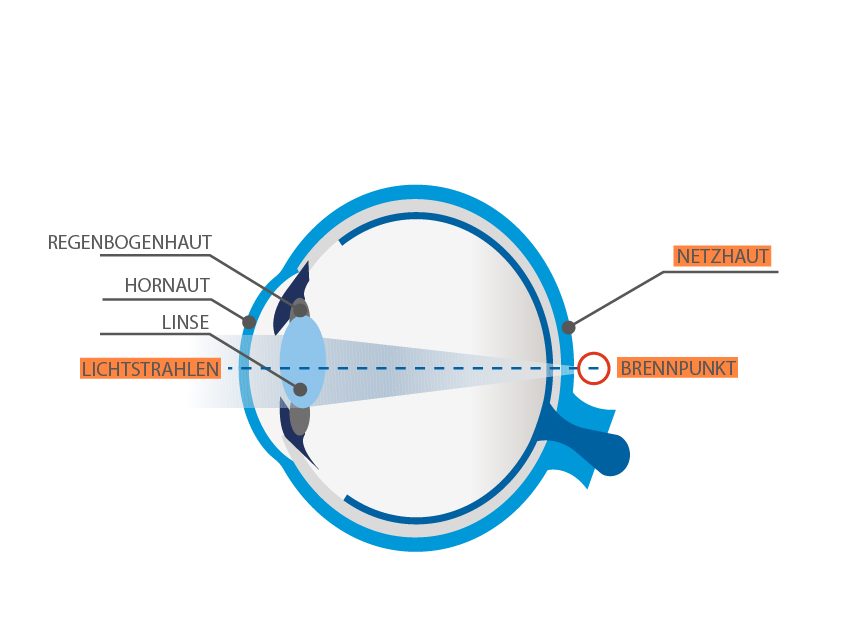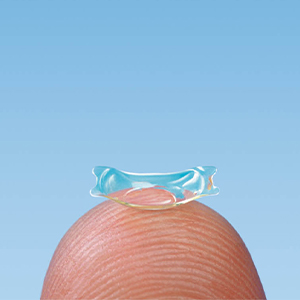How does farsightedness occur?
In the case of long-sightedness, the eyeball is too short, or the refractive power of the eye is too weak in relation to its overall length. Incoming light rays are thus focused behind the retina instead of on it. This results in the blurriness in the close-up range. In order to be able to read books and magazines, long-sighted people like to hold them away from them with their outstretched arm.
At a young age, the eye is able to compensate for the lack of refractive power in the eye by bending the lens more – so-called accommodation. However, since increasing the lens power in this way is limited, it becomes difficult when an object is too close to the eye. From the age of 45, the elasticity of the lens decreases, which makes accommodation even more difficult, so that clear vision at close range becomes increasingly difficult. The refractive power of the eye is measured in diopters. For a far-sighted person, the diopter value is in the plus range.
The most common methods of correcting hyperopia are wearing glasses and/or contact lenses and eye laser correction.


What are the symptoms of farsightedness (Hyperopia)?
With farsightedness, the affected person perceives objects that are far away sharply (“far-sighted”), while they can only see their surroundings blurry.
Possible symptoms of farsightedness are:
- blurred vision at close range
- Headaches
- Tired eyes
- Eye pain
- Burning eyes
Eye laser treatments for farsightedness
Long-sightedness can usually be compensated very well by eye laser treatment. Many patients who come to us complain about fogged up glasses, irritated eyes from contact lenses and cumbersome cleaning procedures. These are usually a thing of the past once the farsightedness has been corrected.
Correction with LASIK, FEMTO-Lasik, PRK/Lasek or the Trans-PRK method is an option for most patients. After a detailed medical examination of your eyes, your treating specialist will determine the best correction method for you. All treatments are performed on an outpatient basis and are painless. The treatment with the Excimer laser only takes a few seconds.

Treatment for farsightedness is not possible – what now?
In the case of particularly severe farsightedness (over +4 diopters), treatment with the laser is usually no longer the optimal correction method. In many cases, an ICL lens treatment can still enable patients to live a life without glasses.
When presbyopia sets in, multifocal lens treatment (MIOL) is a good solution in many cases. Another advantage, in addition to eliminating presbyopia, is that cataracts can no longer occur.
Farsightedness and other ametropia
Yes, long-sightedness and astigmatism can be corrected in one treatment step, provided you are eligible for laser eye surgery. Many patients suffer from a combination of these two ametropia.
Yes, nearsightedness and farsightedness can be corrected very well in most cases with eye laser surgery. A frequently existing astigmatism can also be compensated for in the same surgery procedure.
Frequently asked questions about farsightedness (FAQ)
Long-sighted people can suffer from other ametropia at the same time. Most farsighted people also suffer from astigmatism. In addition, presbyopia can occur from the age of about 40 years. However, it is not possible to be farsighted and shortsighted in one eye at the same time.
Yes, farsightedness has a hereditary component. However, personal factors also have an influence on the occurrence and severity of farsightedness.
Farsightedness of up to 5 diopters can be corrected very well with an eye laser treatment. If a patient suffers from increased farsightedness, lens treatment may be the more appropriate correction method. After a comprehensive preliminary examination of the eyes, the attending ophthalmologist decides which treatment method is best for the patient.
Laser eye treatment can correct farsightedness and astigmatism at the same time. Both ametropia are corrected in one surgery procedure.
The cost of an eye laser treatment to correct long-sightedness at CARE Vision is around 1.150 euros per eye (billing according to GOÄ after the treatment has been completed).
